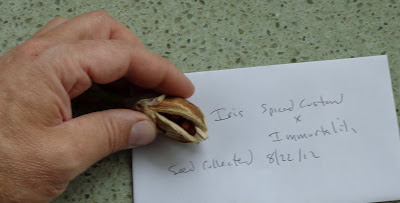Here is my attempt at a deer unfriendly, drought tolerant border. My timing is bad - except for the irises, it would be better to plant in Spring or Fall. There wasn't much choice, since we just took title of the place, and I wanted to get started. On the plus side, there are lots of perennials on close out. The majority of irises are divisions from home, cleaning up beds that went to weeds, and separating some that desperately needed separating. A couple are new starts, and a few are from the new place, cleaned up and replanted. Two patches are left alone, other than weeding and applying compost.
The borders were prepped with a layer of compost, watered a couple of times but otherwise left for a week. That killed much of the invading grass and weeds. Then I dug in the compost, broke up clods, raked with garden rake, and planted. Finally, a layer of compost was added as mulch.

This border gets mainly Western sun, with some parts getting Southern sun. While digging, I repeatedly hit stone. Finally, I used a flat shovel, and discovered a walk made from pavers. It's cleaned up and left in place. The Irises are a mix, I did not label except for the new purchases. I'll know when they bloom. I should do a winter project of making labels.
The dry tolerant, supposedly deer-unfriendly plants include Lavender, Sage, Marjoram,
Monarda, Asclepias, Hibiscus, Oregano, Lemon Thyme, Rosemary, and of course the Irises. I did not plant mints or lemon balm because they are too invasive, but may plant some in the orchard where that doesn't matter.
Asclepias was an impulse buy. I had read about it but didn't expect to find any. It seemed difficult to grow and transplant, based on what I read. One problem is the long tap root, which apparently doesn't like to be disturbed. I broke a rule, and planted from the container without pulling roots out from the rootball. Maybe that will work. If not, it isn't a big loss,. They were 60% off. All of the new starts were on close-out.

This border is south of the deck and gets Southern and Western sun - hot! It includes sage, chives, Monarda, yarrow, Coreopsis, divisions from Bumble Delite Iris - a small variety, and a daylily. The daylily is not deer repellant, so we'll see what happens. Impulse. The chives was a sizable semi-dormant cluster that I moved from my yard at home. I like eating fresh chives in some sandwiches and in eggs, and they are nice to look at. There are some shasta daisies, which grow wild around the yard. I left those in place.

This is a closeup of that front border. There are also some chrysanthemums and lantana. I don't know if deer like those. Also some dusty miller, drought and deer safe, from what I read. Those sausage-shaped brown objects are pine cones.

This bed also gets southern and western sun. It contains 2 columnar apple trees, Red Sentinel and Golden Sentinel; some small shrubs, but mostly irises. Deer can destroy small apple trees, so I sprayed with deer repellant. The irises were the remainder of the divisions, I had removed from my home front yard, some rescues that were hidden in grass and under shrubs. Some had been sitting for a couple of weeks before planting, but irises are tough. I trimmed the leaves and stray roots, and planted randomly. Finally, I also planted the
Allium gigantium bulbs that I dug up from home, in several places, and and a dozen Allium that appear to be a bit smaller, in a mixed bag that I bought at a big store. I marked the locations where the Allium were planted, so I won't overplant them with something else, since they won't come up until next year. As onion family plants, Alliums are not liked by deer, and they go dormant for the summer so dry is not an issue. The big flowers are fun and bees love them.
 Seed pod on plant. This is an Iris Pod, not and I-Pod. They would be cool in a bowl of pine cones and seed heads, or as part of a dried arrangement.
Seed pod on plant. This is an Iris Pod, not and I-Pod. They would be cool in a bowl of pine cones and seed heads, or as part of a dried arrangement.
 A little closer.
A little closer.
 Cut, envelope labeled
Cut, envelope labeled
 Seeds shelled out. They are so loose, they just fall out.
Seeds shelled out. They are so loose, they just fall out.


























